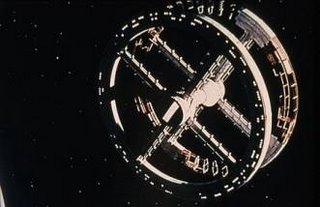2001: The silent space
When Stanley Kubrick released  2001: A space odyssey in 1968, he proved that science-fiction gender didn’t have to consist only in B – movies, but it could be a gender as good as any other to tell more serious stories. Along with this more elevated artistic aim came a greater scientific rigour. Apart from introducing one of the first electronic cinema characters, the famous computer HAL, the movie tried to make space trips look believable, in an age in which these were becoming a reality.
2001: A space odyssey in 1968, he proved that science-fiction gender didn’t have to consist only in B – movies, but it could be a gender as good as any other to tell more serious stories. Along with this more elevated artistic aim came a greater scientific rigour. Apart from introducing one of the first electronic cinema characters, the famous computer HAL, the movie tried to make space trips look believable, in an age in which these were becoming a reality.
The mute takes of outer space were a shocking com ponent of the movie. Space is full of light coming from the stars but it is quiet; sound can’t be transmitted through it. Light is able to spread through a vacuum, just like heat, but sound is a pressure wave instead: air particles collide and transmit a vibration which is turned into sound when reaching our eardrums. Therefore, there can be no sound without any atmospheric air, so when we hear the spacecrafts’ collisions and explosions in a countless number of movies, we must think that we are dealing with one of those well known poetic licenses of movie makers.
ponent of the movie. Space is full of light coming from the stars but it is quiet; sound can’t be transmitted through it. Light is able to spread through a vacuum, just like heat, but sound is a pressure wave instead: air particles collide and transmit a vibration which is turned into sound when reaching our eardrums. Therefore, there can be no sound without any atmospheric air, so when we hear the spacecrafts’ collisions and explosions in a countless number of movies, we must think that we are dealing with one of those well known poetic licenses of movie makers.
 2001: A space odyssey in 1968, he proved that science-fiction gender didn’t have to consist only in B – movies, but it could be a gender as good as any other to tell more serious stories. Along with this more elevated artistic aim came a greater scientific rigour. Apart from introducing one of the first electronic cinema characters, the famous computer HAL, the movie tried to make space trips look believable, in an age in which these were becoming a reality.
2001: A space odyssey in 1968, he proved that science-fiction gender didn’t have to consist only in B – movies, but it could be a gender as good as any other to tell more serious stories. Along with this more elevated artistic aim came a greater scientific rigour. Apart from introducing one of the first electronic cinema characters, the famous computer HAL, the movie tried to make space trips look believable, in an age in which these were becoming a reality.The mute takes of outer space were a shocking com
 ponent of the movie. Space is full of light coming from the stars but it is quiet; sound can’t be transmitted through it. Light is able to spread through a vacuum, just like heat, but sound is a pressure wave instead: air particles collide and transmit a vibration which is turned into sound when reaching our eardrums. Therefore, there can be no sound without any atmospheric air, so when we hear the spacecrafts’ collisions and explosions in a countless number of movies, we must think that we are dealing with one of those well known poetic licenses of movie makers.
ponent of the movie. Space is full of light coming from the stars but it is quiet; sound can’t be transmitted through it. Light is able to spread through a vacuum, just like heat, but sound is a pressure wave instead: air particles collide and transmit a vibration which is turned into sound when reaching our eardrums. Therefore, there can be no sound without any atmospheric air, so when we hear the spacecrafts’ collisions and explosions in a countless number of movies, we must think that we are dealing with one of those well known poetic licenses of movie makers.
1 Comments:
The sound (or lack thereof) was indeed one of the most incredible things about 2001 .. it made it as creepy as it was realistic, and just amazing to watch
Post a Comment
<< Home